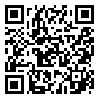BibTeX | RIS | EndNote | Medlars | ProCite | Reference Manager | RefWorks
Send citation to:
URL: http://jdisabilstud.org/article-1-2202-en.html
2- Professor, Department of Psychology, Sari Branch, Islamic Azad University, Sari, Iran
3- Assistant Professor, Department of Psychology, Sari Branch, Islamic Azad University, Sari, Iran
Abstract
Background & Objectives: Adolescence is an essential and vital period. In the last two decades, research has shown that high–risk and threatening behaviors have increased among adolescents and young people and pose a serious threat to public health. Many factors have been identified and introduced in the occurrence of risky behaviors, including life satisfaction. Due to inefficient coping with stressful factors, harmful consequences such as depression, anxiety, aggression, and self–harm will plague teenagers. Adaptive emotion regulation strategies negatively predict the ideation of high–risk behaviors, while maladaptive cognitive emotion regulation strategies positively predict adolescents' mental risk–taking. Since adolescents constitute a large segment of the population, researchers should recognize and examine their problems and issues. This study aimed to present a causal model of the components of coping strategies with stress and risk–taking with the mediating role of life satisfaction in male high school students.
Methods: The research method was descriptive–correlational based on structural equation modeling (SEM). The statistical population of this study consisted of all ninth–grade junior high school students studying in the second semester of 2018–19 in Babol City, Iran. The sample size was estimated at 240 people according to the number of observed variables, and a coefficient of 15 was assigned for each observed variable (16 variables observed in the model), as well as considering the possibility of incomplete questionnaires. The samples were selected by two–stage cluster probability sampling. First, one of the education districts of Babol was chosen randomly (District 2), and then three high schools were randomly selected from the mentioned district. All ninth–grade students of these schools answered the questionnaires. Students answered the Satisfaction with Life Scale (Diner et al., 1985), the Iranian Adolescents Risk–taking Scale (Zadeh Mohammadi et al., 2011), and the Coping Strategies Questionnaire (Endler & Parker, 1990). In this research, descriptive statistics was used to categorize the individual characteristics of the subjects by calculating the frequency, percentage, mean, and standard deviation. Also, the inferential statistics, including the Pearson correlation coefficient and structural equation modeling, were also performed to analyze the data in SPSS version 22 and AMOS version 22 software. The significance level in this study was set at 0.05.
Results: The direct path coefficient between stress–coping strategies and risk–taking was significant and positive (p=0.005, β=0.22). Also, the direct path coefficients between stress coping strategies and life satisfaction (p=0.001, β=–0.28) and between life satisfaction and risk–taking (p=0.001, β=–0.50) were negative and significant. The indirect path of stress coping strategies on risk–taking with the mediation of life satisfaction was confirmed using the bootstrap estimation method (p < 0.001, β = 0.220). The goodness of fit indices supported the good fit of the model with the collected data (AGFI=0.95, RMSEA=0.043, GFI=0.98, CFI=0.97, χ2/df=2.87).
Conclusion: Based on the research findings, coping strategies and life satisfaction explain students' risk–taking. Using skills to increase students' satisfaction with life can help students identify their mental state and coping strategies in stressful situations.
| Rights and permissions | |
 |
This work is licensed under a Creative Commons Attribution-NonCommercial 4.0 International License. |



